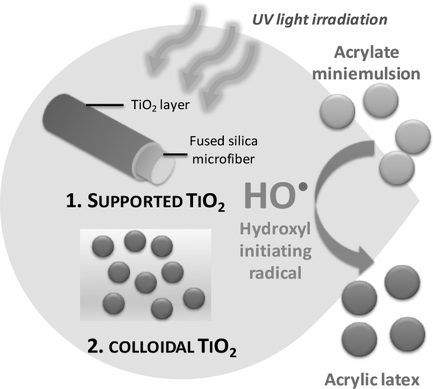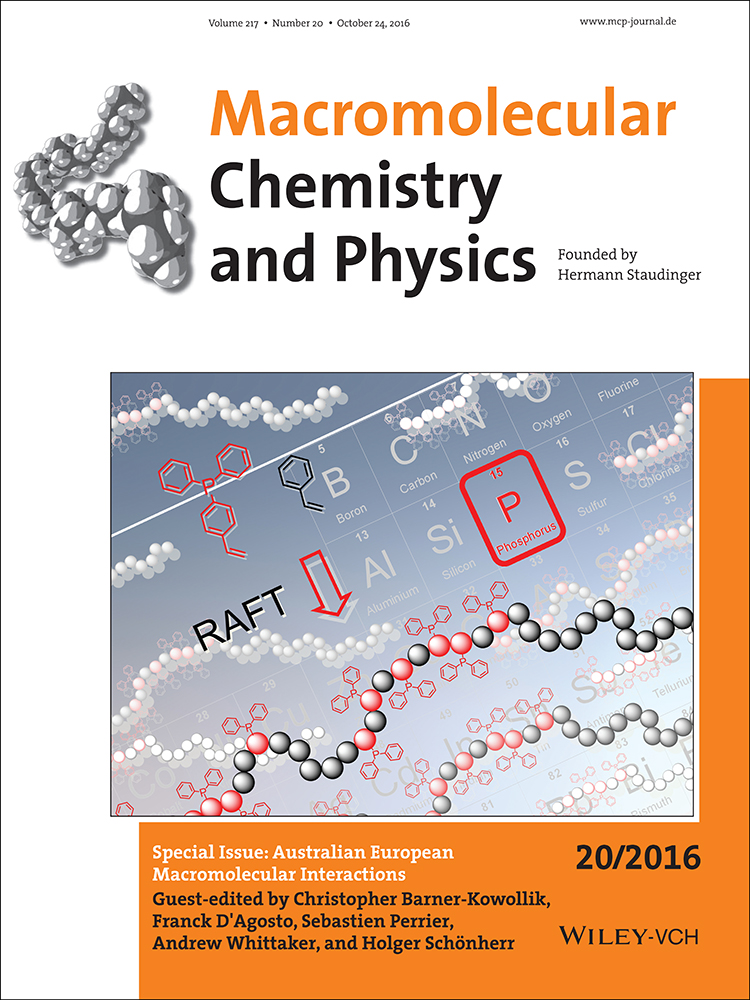Colloidal and Supported TiO2: Toward Nonextractable and Recyclable Photocatalysts for Radical Polymerizations in Aqueous Dispersed Media
Emeline Lobry
Laboratory of Macromolecular Photochemistry and Engineering, University of Haute-Alsace, 3 rue Alfred Werner, 68093 Mulhouse Cedex, France
Search for more papers by this authorAbdoul Salam BT Bah
Laboratory of Macromolecular Photochemistry and Engineering, University of Haute-Alsace, 3 rue Alfred Werner, 68093 Mulhouse Cedex, France
Search for more papers by this authorLoïc Vidal
Institut de Science des Matériaux de Mulhouse, CNRS UMR 7361, University of Haute-Alsace, 15 rue Jean Starcky, 68057 Mulhouse, France
Search for more papers by this authorEsther Oliveros
Laboratoire des Interactions Moléculaires et Réactivité Chimique et Photochimique (IMRCP), UMR 5623-CNRS/UPS, Université Toulouse III Paul Sabatier, 118, route de Narbonne, 31062 Toulouse Cedex 9, France
Search for more papers by this authorAndré M. Braun
Engler-Bunte-Institute, Karlsruhe Institute of Technology, 76131 Karlsruhe, Germany
Search for more papers by this authorAdrien Criqui
Mäder Research, MADER GROUP, 130 rue de la Mer Rouge, 68200 Mulhouse, France
Search for more papers by this authorCorresponding Author
Abraham Chemtob
Institut de Science des Matériaux de Mulhouse, CNRS UMR 7361, University of Haute-Alsace, 15 rue Jean Starcky, 68057 Mulhouse, France
E-mail: [email protected]Search for more papers by this authorEmeline Lobry
Laboratory of Macromolecular Photochemistry and Engineering, University of Haute-Alsace, 3 rue Alfred Werner, 68093 Mulhouse Cedex, France
Search for more papers by this authorAbdoul Salam BT Bah
Laboratory of Macromolecular Photochemistry and Engineering, University of Haute-Alsace, 3 rue Alfred Werner, 68093 Mulhouse Cedex, France
Search for more papers by this authorLoïc Vidal
Institut de Science des Matériaux de Mulhouse, CNRS UMR 7361, University of Haute-Alsace, 15 rue Jean Starcky, 68057 Mulhouse, France
Search for more papers by this authorEsther Oliveros
Laboratoire des Interactions Moléculaires et Réactivité Chimique et Photochimique (IMRCP), UMR 5623-CNRS/UPS, Université Toulouse III Paul Sabatier, 118, route de Narbonne, 31062 Toulouse Cedex 9, France
Search for more papers by this authorAndré M. Braun
Engler-Bunte-Institute, Karlsruhe Institute of Technology, 76131 Karlsruhe, Germany
Search for more papers by this authorAdrien Criqui
Mäder Research, MADER GROUP, 130 rue de la Mer Rouge, 68200 Mulhouse, France
Search for more papers by this authorCorresponding Author
Abraham Chemtob
Institut de Science des Matériaux de Mulhouse, CNRS UMR 7361, University of Haute-Alsace, 15 rue Jean Starcky, 68057 Mulhouse, France
E-mail: [email protected]Search for more papers by this authorAbstract
Two high surface area titania forms, dispersed as stable nanoparticles or coated on fused silica microfiber, are used as nonleachable photocatalysts for the radical photopolymerization of methyl methacrylate miniemulsion in water. At low loading (0.17 wt%/wtmonomer), both nanoscale TiO2 yield ≈50% conversion after 10 min UV irradiation, compared to 63% with a conventional type I photoinitiatior (hydroxyacetophenone). High-molecular-weight values (>180 kDa) and a polydispersity index of about 1.5 are achieved, indicating that undesirable degradation is negligible. In the proposed mechanism, a surface initiation takes place through the generation of hydroxyl radicals from H2O oxidation. It is shown that irradiance and TiO2 content are two key parameters for controlling molecular weight and conversion values. The supported TiO2 form can be easily recovered and reused up to four times, despite a gradual reduction in conversion. Deposited on the wall of the annular photochemical reactor, it enables reaction scaling-up.
Supporting Information
As a service to our authors and readers, this journal provides supporting information supplied by the authors. Such materials are peer reviewed and may be re-organized for online delivery, but are not copy-edited or typeset. Technical support issues arising from supporting information (other than missing files) should be addressed to the authors.
| Filename | Description |
|---|---|
| macp201600150-sup-0001-S1.pdf827.1 KB | Supplementary |
Please note: The publisher is not responsible for the content or functionality of any supporting information supplied by the authors. Any queries (other than missing content) should be directed to the corresponding author for the article.
References
- 1M. Schmitt, Macromol. Chem. Phys. 2012, 213, 1953.
- 2W. A. Green, Industrial Photoinitators: A Technical Guide, CRC Press, New York, USA 2010.
10.1201/9781439827468 Google Scholar
- 3J. L. Aparicio, M. Elizalde, Packag. Technol. Sci. 2015, 28, 181.
- 4S. Dadashi-Silab, C. Aydogan, Y. Yagci, Polym. Chem. 2015, 6, 6595.
- 5J. P. Fouassier, J. Lalevée, Photoinitiators for Polymer Synthesis: Scope, Reactivity and Efficiency, Wiley-VCH Verlag GmbH & Co. KGaA, Weinheim, Germany 2012.
10.1002/9783527648245 Google Scholar
- 6M. Schmitt, Nanoscale 2015, 7, 9532.
- 7Z.-Y. Huang, T. Barber, G. Mills, M.-B. Morris, J. Phys. Chem. 1994, 98, 12746.
- 8I. G. Popović, L. Katsikas, H. Weller, Polym. Bull. 1994, 32, 597.
- 9J. C. Kuriacose, M. C. Markham, J. Phys. Chem. 1961, 65, 2232.
- 10M. Yamamoto, G. Oster, J. Polym. Sci., Part A: Polym. Chem. 1966, 4, 1683.
- 11A. J. Hoffman, H. Yee, G. Mills, M. R. Hoffmann, J. Phys. Chem. 1992, 96, 5540.
- 12B. L. Funt, S.-R. Tan, J. Polym. Sci., Part A: Polym. Chem. 1984, 22, 605.
- 13O. Legrini, E. Oliveros, A. M. Braun, Chem. Rev. 1993, 93, 671.
- 14T. Oppenländer, Photochemical Purification of Water and Air: Advanced Oxidation Processes (AOPs): Principles, Reaction Mechanisms, Reactor Concepts, Wiley-VCH Verlag GmbH&Co. KGaA, Weinheim, Germany 2002.
10.1002/9783527610884 Google Scholar
- 15A. R. Ribeiro, O. C. Nunes, M. F. R. Pereira, A. M. T. Silva, Environ. Int. 2015, 75, 33.
- 16B. Kraeutler, H. Reiche, A. J. Bard, R. G. Hocker, J. Polym. Sci. Polym. Lett. Ed. 1979, 17, 535.
- 17C. Damm, D. Völtzke, H.-P. Abicht, G. Israel, J. Photochem. Photobiol. A 2005, 174, 171.
- 18C. Damm, J. Photochem. Photobiol. A 2006, 181, 297.
- 19C. Damm, R. Herrmann, G. Israel, F. W. Müller, Dyes Pigments 2007, 74, 335.
- 20A. L. Stroyuk, V. M. Granchak, A. V. Korzhak, S. Y. Kuchmii, J. Photochem. Photobiol. A 2004, 162, 339.
- 21D. Yang, X. Ni, W. Chen, Z. Weng, J. Photochem. Photobiol. A 2008, 195, 323.
- 22J. Ye, X. Ni, C. Dong, J. Macromol. Sci., Part A 2005, 42, 1451.
- 23A. L. Stroyuk, I. V. Sobran, S. Y. Kuchmiy, J. Photochem. Photobiol. A 2007, 192, 98.
- 24S. Dadashi-Silab, A. M. Asiri, S. B. Khan, K. A. Alamry, Y. Yagci, J. Polym. Sci., Part A: Polym. Chem. 2014, 52, 1500.
- 25S. Dadashi-Silab, M. A. Tasdelen, A. Mohamed Asiri, S. B. Khan, Y. Yagci, Macromol. Rapid Commun. 2014, 35, 454.
- 26J. Yan, B. Li, F. Zhou, W. Liu, ACS Macro Lett. 2013, 2, 592.
- 27D. Zhang, J. Yang, S. Bao, Q. Wu, Q. Wang, Sci. Rep. 2013, 3, 1399.
- 28X. Ni, J. Ye, C. Dong, J. Photochem. Photobiol. Chem. 2006, 181, 19.
- 29C. Dong, X. Ni, J. Macromol. Sci., Part A 2004, 41, 547.
- 30Z. Wei, C. Zou, X. Ni, J. Appl. Polym. Sci. 2014, 131, 10.1002/app.40187.
10.1002/app.40986 Google Scholar
- 31X. Song, Y. Zhao, H. Wang, Q. Du, Langmuir 2009, 25, 4443.
- 32X. Song, G. Yin, Y. Zhao, H. Wang, Q. Du, J. Polym. Sci., Part A: Polym. Chem. 2009, 47, 5728.
- 33R. L. Pozzo, M. A. Baltanás, A. E. Cassano, Catal. Today 1997, 39, 219.
- 34G. Li, K. A. Gray, Chem. Phys. 2007, 339, 173.
- 35T. Luttrell, S. Halpegamage, J. Tao, A. Kramer, E. Sutter, M. Batzill, Sci. Rep. 2014, 4, 4043.





